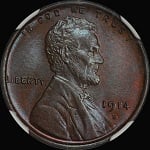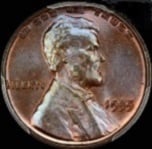Ceck out this OLD Error Cents Book from 1963 (photos taken with new iPhone 5)
Just picked up this really neat old Flying Eagle, Indian and Lincoln cent error book by Michael Kolman, Jr. Notice the prices from 1969 - what a hoot!
I took some photos of it with my BRAND NEW IPHONE 5 - so hopefully when I post photos for my upcoming Baltimore show report, the photos will be much better quality (though that term is relative considering the picture taker!).




I took some photos of it with my BRAND NEW IPHONE 5 - so hopefully when I post photos for my upcoming Baltimore show report, the photos will be much better quality (though that term is relative considering the picture taker!).




0



Comments
Cool!
Question - What does "Second strike in K. 12." mean? Or another one references K. 9.
designed a positioning chart to determine where the
off center strike, or clipped planchet, occured.
Their system was called the Kolit Position - Kolman/Litman.
It was then shortened to the "K" reference you see in the book.
Since about the early 70's, collectors just use the clock position
now for reference.
Hope this helps.
<< <i>In the "old days", Michael Kolman and Charles Litman
designed a positioning chart to determine where the
off center strike, or clipped planchet, occured.
Their system was called the Kolit Position - Kolman/Litman.
It was then shortened to the "K" reference you see in the book.
Since about the early 70's, collectors just use the clock position
now for reference.
Hope this helps. >>
Hey Fred.....do the young whippersnappers know what a "clock" is?????
TD
Too many positive BST transactions with too many members to list.
<< <i>Just picked up this really neat old Flying Eagle, Indian and Lincoln cent error book by Michael Kolman, Jr. Notice the prices from 1969 - what a hoot! >>
Kolman did a few different books on Small Cent errors as early as 1956.
Since no one else since has covered this area, his books are still mighty useful.
<< <i>Are those type of errors done intentionally? Aren't coins struck in collars so I was wondering how you could get an impression on the edge of a previously struck coin in a collar? I am just trying to imagine how that happens and cannot picture it. >>
I do not understand the question. Please expand.
<< <i>You shot those photos in black and white.
Cool! >>
.
CoinsAreFun Toned Silver Eagle Proof Album
.
Gallery Mint Museum, Ron Landis& Joe Rust, The beginnings of the Golden Dollar
.
More CoinsAreFun Pictorials NGC FOR SALE
I only wish I started collecting those when I was 7 years old in 1969
Very cool pick up Charmy.
'clear' photos of major errors, as opposed
to Coin World Collector's Clearninghouse
Photos, which were good, but weren't
the same printing process as this book.
Tom - sorry; no disrespect! (this was before
you were there, anyway!)
I know of at least four collections of Indian
Cent errors that have some of these coins in
them........and I'm sure the others are in
nice collections too.
<< <i>
<< <i>In the "old days", Michael Kolman and Charles Litman
designed a positioning chart to determine where the
off center strike, or clipped planchet, occured.
Their system was called the Kolit Position - Kolman/Litman.
It was then shortened to the "K" reference you see in the book.
Since about the early 70's, collectors just use the clock position
now for reference.
Hope this helps. >>
Hey Fred.....do the young whippersnappers know what a "clock" is?????
TD >>
no more cursive in school. how much longer for clocks with hands, i don't know.
<< <i>Wow, the prices on those coins are insanely low.
I only wish I started collecting those when I was 7 years old in 1969
Very cool pick up Charmy. >>
shhhhh
maybe she will use it as a new price guide
Sean Reynolds
"Keep in mind that most of what passes as numismatic information is no more than tested opinion at best, and marketing blather at worst. However, I try to choose my words carefully, since I know that you guys are always watching." - Joe O'Connor
<< <i>Are those type of errors done intentionally? Aren't coins struck in collars so I was wondering how you could get an impression on the edge of a previously struck coin in a collar? I am just trying to imagine how that happens and cannot picture it. >>
When stamped coins are not ejected from the collar properly, a portion of the coin that was just stamped hangs over the edge of the collar and when the dies come together again a partial stamp is made on the portion that is in the way of the hammer and anvil. That's how you get a partial or off-center strike on a blank planchet also.
Too many positive BST transactions with too many members to list.
<< <i>Okay, I want one of those books now. Very cool pick-up, Charmy. Can you show a quick picture of some of the Lincoln cent errors?
Sean Reynolds >>
Sean, there aren't that many pictures in the book, but here are a couple from the Lincoln section...
The Penny Lady®
Keeper of the VAM Catalog • Professional Coin Imaging • Prime Number Set • World Coins in Early America • British Trade Dollars • Variety Attribution
Also I noticed this in the last picture:
"(No mention is made relating to minor die varieties or clipped cents)"
PPPppbbbttbtbtbbttbthhhthhth....
Sean Reynolds
"Keep in mind that most of what passes as numismatic information is no more than tested opinion at best, and marketing blather at worst. However, I try to choose my words carefully, since I know that you guys are always watching." - Joe O'Connor
<< <i>Thanks, Charmy. The triple-struck cent looks like it was struck with counterfeit dies to me, there is no hint of a collar scar on any of the later strikes.
Also I noticed this in the last picture:
"(No mention is made relating to minor die varieties or clipped cents)"
PPPppbbbttbtbtbbttbthhhthhth....
Sean Reynolds >>
That triple strike is indeed suspicious. A lot of fake multiple strikes came out around 1963-64, but they may have had an early start.
Does anybody have a set of 1958 "The Numismatists" handy? Could you check the convention reports late in the year and see if there is any mention of this coin or its exhibit? I am curious whose exhibit it was, if other than the Charles Harvey indicated in the book.
(Just as an aside, I wonder if there is any connection between the [probable] counterfeiter of this piece and the [reportedly counterfeit] 1959-D wheat cents? Both show a high degree of technical expertise. I have no reason to connect them, but am curious.)
TD
this book, as well as quite a few in the
Spadone error Books.
Knowledge of the minting process wasn't
as deep or fully understood at that time
(outside the Mint), and many collectors
and dealers didn't know, and couldn't tell,
the difference between a genuine error
coin, and a counterfeit piece; sometimes
damaged/altered coins fooled them also.
However, many photos from this era, including
some in the Don Taxay books, are 'snapshots'
of either great errors, or what was known/assumed
at that time - and some turned out to be NG !